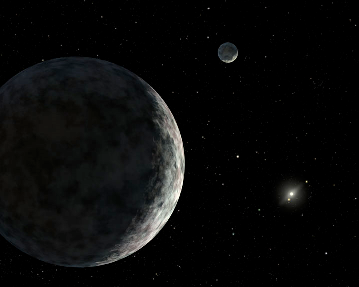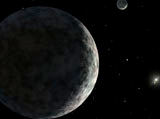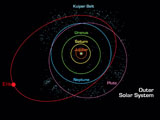Eris is a dwarf planet located in the outermost section of the solar system. So far, it is the largest dwarf planet discovered. It is also the second most reflective body in the solar system. These are many other facts that make Eris an interesting body.
Artist Concept of Eris, Dysnomia and the Sun Image Source
Why Is It Called Eris?
Since its discovery, Eris has had three names. Immediately after it was discovered, scientists labeled it 2003UB313 then named it Xena. The discovery than it was bigger than Pluto led scientists to reconsider the definition of a planet. They decided to classify it as a dwarf planet together with Pluto.
This decision stirred so much controversy that Eris was named after the Greek goddess of discord and strife. In Greek mythology, Eris was believed to cause jealousy and envy among other goddesses eventually causing the Trojan War.
Why Is Eris Not A True Planet?
After its discovery, scientists were not sure whether to classify Eris as the 10th planet. It was bigger than Pluto, which was then classified as a true planet.
However, it did not qualify to be classified as a planet because of its small size, which means it does not have the gravitational force required to have a clear orbit. Its space is occupied by other objects. All planets must have a clear orbit that is not cluttered by other bodies.
Finally, the International Astronomical Union decided to classify it as a dwarf planet. Being smaller than Eris, Pluto could not keep its status as a planet. It was also demoted to a dwarf planet.
How Was Eris Discovered?
Eris was first spotted in 2003. Its discovery was confirmed in July 2005 by a team of scientists who were studying two year old images captured by the Palomar Observatory in California.
Does Eris Have a Moon?
Yes, Eris has a small moon named Dysnomia, after Eris’s daughter, the demon goddess of lawlessness. Dysnomia is about 8 times smaller than its parent dwarf planet and takes about two weeks to complete an orbit around its parent dwarf planet. Astronomers are exploring Eris and its moon closely to learn more.
Eris and Dysmonia Image Source: NASA
Is It Possible To See Eris?
Because of its extremely small size and distant location, Eris cannot be spotted with the unaided eye. It can only be seen using high-end amateur telescope provided you know where to look. Even then, it takes a skilled and experienced person to be able to spot it, as it appears as a tiny dot of light. You can determine its exact location by using the Horizons System.
How Far away is Eris?
Eris is extremely far away from the sun, even further away than Pluto. It is located in the Kuiper Belt, which is found around the edge of the solar system. Specifically, it resides in the region referred to as the scattered disk.
It takes 557 Earth years for Eris to complete its highly elliptical orbit around the sun.
Extremely Tilted Orbit of Eris Image Source: NASA
How Big Is Eris?
To determine the size of an object that is as small and as far away as Eris, astronomers use advanced telescopes to determine its heat output and calculate its size. Eris is so small that even the powerful Spitzer Telescope could not detect its heat output.
The first breakthrough in determining the size of Eris was when the IRAM Telescope was able to detect its heat output and predict its diameter measurements to be 3000+-400km. The latest measurements were made from observations through the Hubble Space Telescope, which showed its diameter as 2400 +/- 100 km.
Eris is a Near Perfect Pluto Twin
After its discovery, scientists believed Eris was significantly larger than Pluto. Using advanced equipment to observe it and calculate its size, scientists have discovered that they were wrong. Eris and Pluto are almost the same size making them almost perfect twins.
By studying the orbit of Dysnomia, its moon, astronomers have also been able to estimate that Eris is 27% more massive than Pluto.
Eris is the Second Most Reflective Bodies in the Solar System
Eris is the second most reflective object in the solar system after Saturn’s icy moon Enceladus. Astronomers believe this is because its surface may be composed of a thin layer of ice. As Eris moves away from the sun in its orbit, its atmosphere freezes and falls on its surface to form a thin cover of ice. Snow is one of the most reflective materials.
How Do We Know So Much About Eris?
If no mission has been made to Eris, it is natural to wonder how we know so much about this distant and tiny body.
In 2010, Eris passed in front of a dim star. This event is known as an occultation and it presented a great opportunity to discover more about this distant body. Astronomers observed this event from 26 different locations.
In two of these observation sites, the faint star was shortly blocked by Eris. These observations made it possible to calculate the size of Eris accurately and determine that it is spherical in shape.
What is The Composition of Eris?
By estimating the density of Eris, scientists have been able to predict that it is composed of rocks. Its immense ability to reflect light indicates that the rocks are covered by a thin sheet of ice, which results from the atmosphere freezing. Scientists believe that this atmosphere will thaw as Eris comes closer to the sun leaving a rocky surface similar to that of Pluto.
How cold is Eris?
Being very far away from the sun, Eris is extremely cold. Its Temperature varies from -359 degrees Fahrenheit (-217 degrees Celsius) to -405 degrees Fahrenheit (-243 degrees Celsius).



